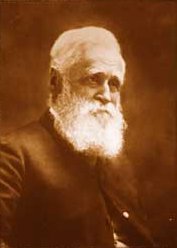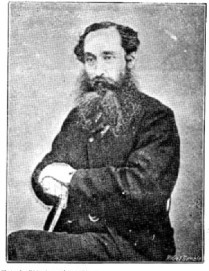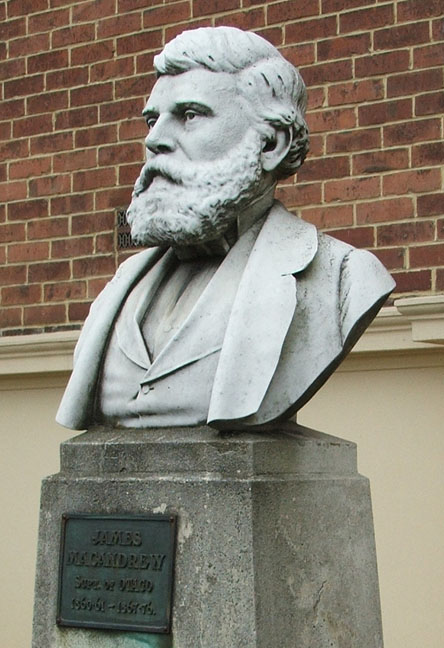|
Bruce (New Zealand Electorate)
Bruce was a rural parliamentary electorate in the Otago region of New Zealand, from 1861 to 1922. For part of the 1860s with the influx to Otago of gold-miners it was a multi-member constituency with two members. Population centres In 1865 the Bruce electorate included Tokomairiro, Waihola, East Taieri, suburbs of Dunedin, Inch Clutha, Lawrence, Warepa and Pomahaka. History The Bruce electorate was formed in the 1860 electoral redistribution. It covered the rural area surrounding Dunedin that had previously been part of the Dunedin Country electorate. The Bruce electorate was a two-member constituency. The electorate was named after Robert the Bruce who was King of Scotland from 1306 to 1329. Charles Kettle and Thomas Gillies were the only two candidates for the newly constituted two-member electorate of Bruce. They were thus declared elected unopposed on 11 February 1861. Kettle died on 5 June 1862. Edward Cargill succeeded him in the 1862 by-election. Thomas Gillies resigne ... [...More Info...] [...Related Items...] OR: [Wikipedia] [Google] [Baidu] |
New Zealand Electorates
An electorate or electoral district ( mi, rohe pōti) is a geographical constituency used for electing a member () to the New Zealand Parliament. The size of electorates is determined such that all electorates have approximately the same population. Before 1996, all MPs were directly chosen for office by the voters of an electorate. In New Zealand's electoral system, 72 of the usually 120 seats in Parliament are filled by electorate members, with the remainder being filled from party lists in order to achieve proportional representation among parties. The 72 electorates are made up from 65 general and seven Māori electorates. The number of electorates increases periodically in line with national population growth; the number was increased from 71 to 72 starting at the 2020 general election. Terminology The Electoral Act 1993 refers to electorates as "electoral districts". Electorates are informally referred to as "seats", but technically the term '' seat'' refers to an electe ... [...More Info...] [...Related Items...] OR: [Wikipedia] [Google] [Baidu] |
April 1865 Bruce By-election
The April 1865 Bruce by-election was a New Zealand by-election held in the multi-member electorate of during the 3rd New Zealand Parliament on 8 April 1865. It was triggered on 9 January that year by the resignation of separationist Thomas Gillies and won by prominent settler Arthur John Burns. The more liberal businessman William John Dyer was the sole other contester of the by-election, finishing with 43.33% of the vote. Five candidates were nominated but two of them had their nominations rejected by the Returning Officer. Both rejected nominees had nominated other electors earlier in the meeting; the Returning Officer believed this behaviour was childish and contrary to the "serious duty" of candidacy. A third nominee—Henry Clapcott—was proposed but withdrew prior to the election. The by-election was one of three by-elections in the electorate that were also in the 3rd Parliament, the others being the July 1865 by-election and the 1862 by-election. 11 months after ... [...More Info...] [...Related Items...] OR: [Wikipedia] [Google] [Baidu] |
James McDonald (New Zealand Politician)
James McDonald (1837 – 12 March 1900) was a 19th-century Member of Parliament in Otago, New Zealand. He represented the Bruce The English language name Bruce arrived in Scotland with the Normans, from the place name Brix, Manche in Normandy, France, meaning "the willowlands". Initially promulgated via the descendants of king Robert the Bruce (1274−1329), it has been a ... electorate from to 1884, when he was defeated by Robert Gillies. References 1837 births 1900 deaths 19th-century New Zealand politicians Members of the New Zealand House of Representatives New Zealand MPs for South Island electorates Unsuccessful candidates in the 1884 New Zealand general election {{NewZealand-politician-stub ... [...More Info...] [...Related Items...] OR: [Wikipedia] [Google] [Baidu] |
James Rutherford (New Zealand Politician)
James Rutherford (1825 – 16 May 1883) was a 19th-century Member of Parliament in Otago, New Zealand. He represented the Bruce The English language name Bruce arrived in Scotland with the Normans, from the place name Brix, Manche in Normandy, France, meaning "the willowlands". Initially promulgated via the descendants of king Robert the Bruce (1274−1329), it has been a ... electorate from 1881 to 1883, when he died. References 1825 births 1883 deaths Members of the New Zealand House of Representatives New Zealand MPs for South Island electorates 19th-century New Zealand politicians {{NewZealand-politician-stub ... [...More Info...] [...Related Items...] OR: [Wikipedia] [Google] [Baidu] |
William Murray (New Zealand Politician)
William Archibald Murray (1832 – 26 June 1900) was a 19th-century Member of Parliament in Otago, New Zealand. During his time in parliament, he moved to the Waikato. Biography Brothers William, John (died 1896), and James Murray (died 1899) arrived in Dunedin, New Zealand from Scotland aboard the ''Nourmahal'' on 16 April 1858. Their parents John and Jane, two more brothers, Thomas and George, and George's wife and three children, arrived in Dunedin aboard the ''Agra'' in October later that year. The family had, for several generations, farmed 880acres at Marygold in Bunkle and Preston, Berwickshire, Scotland, but came to New Zealand presumably for the opportunity it then provided to acquire and develop land. Initially, William bought 3,000 acres of land in the Waitahuna districts in Otago in partnership with his brother James while his brother Thomas acquired 8,000acres at Mount Stuart just to the South. George bought land in East Taieri and greatly expanded the family Boarder ... [...More Info...] [...Related Items...] OR: [Wikipedia] [Google] [Baidu] |
1871 New Zealand General Election
The 1871 New Zealand general election was held between 14 January and 23 February to elect 78 MPs across 72 electorates to the fifth session of the New Zealand Parliament. 41,527 electors were registered. Background 1871 was the first general election to include the four Māori electorates, with elections held on 1 and 15 February. The first Māori Members of Parliament had been elected in 1868, but in 1871 three retired and one (Western Maori) was defeated. So in 1871 four new Māori MPs were elected. In 1866 the secret ballot was introduced for general (European) elections. The 1871 general election was the first one at which it was used. The secret ballot not used in Māori electorates until 1938, thus Māori voters continued to inform a polling officer orally of their chosen candidate. The date of election is defined here as the day on which the poll took place, or if there was no contest, the day of nomination. The earliest election day was 14 January 1871. The earliest da ... [...More Info...] [...Related Items...] OR: [Wikipedia] [Google] [Baidu] |
Tuapeka (New Zealand Electorate)
Tuapeka is a former parliamentary electorate in the Otago region of New Zealand, from 1871 to 1911. Population centres The 1870 electoral redistribution was undertaken by a parliamentary select committee based on population data from the 1867 New Zealand census. Eight sub-committees were formed, with two members each making decisions for their own province; thus members set their own electorate boundaries. The number of electorates was increased from 61 to 72, and Tuapeka was one of the new electorates. The Tuapeka electorate was landlocked and inland from the electorate. The town of Lawrence was within the electorate. In the 1875 electoral redistribution, the electorate's area was unaltered, but boundary changes were introduced in subsequent electoral redistributions. In the 1890 electoral redistribution, the electorate moved further inland and the settlements of Tapanui and Roxburgh were gained. In the 1892 electoral redistribution, the electorate moved further inland again an ... [...More Info...] [...Related Items...] OR: [Wikipedia] [Google] [Baidu] |
1870 Bruce By-election
The 1870 Bruce by-election was held on 21 March 1870 in the electorate after the resignation of John Cargill during the 4th Parliament. He was replaced by James Clark Brown. Brown was nominated by John Lillie Gillies John Lillie Gillies (1832 – 27 September 1897) was a 19th-century Member of Parliament from the Otago region of New Zealand. He was from Rothesay, Bute on the Isle of Bute, Scotland. Gillies was a member of the Otago Provincial Council, rep ... and seconded by Henry Clark; 25 electors were present. As there was only one nomination, he was declared elected unopposed. Brown was described as an "Anti-Ministerialist". References Bruce 1870 1870 elections in New Zealand Politics of Otago March 1870 events {{NewZealand-election-stub ... [...More Info...] [...Related Items...] OR: [Wikipedia] [Google] [Baidu] |
James Clark Brown
James Clark Brown (December 1830 – 6 February 1891) was a 19th-century Member of Parliament in Otago, New Zealand. He stood unsuccessfully in the for ; a contemporary report saying that his loss was due to ''his own inaction'' and also to the small number of miners and settlers on the electoral roll. He was a resident of Lawrence. He represented the Bruce The English language name Bruce arrived in Scotland with the Normans, from the place name Brix, Manche in Normandy, France, meaning "the willowlands". Initially promulgated via the descendants of king Robert the Bruce (1274−1329), it has been ... electorate in (from 21 March to 30 December), and then the Tuapeka electorate from 1871 to 1890, when he was defeated. He represented Tuapeka on the Otago Provincial Council from 1865 to 1876. His obituary says that he was born in Macclesfield, Cheshire, England and died in St Clair, Dunedin. References * 1830 births 1891 deaths Members of the ... [...More Info...] [...Related Items...] OR: [Wikipedia] [Google] [Baidu] |
1866 New Zealand General Election
The 1866 New Zealand general election was held between 12 February and 6 April to elect 70 MPs to the fourth term of the New Zealand Parliament. In 1867 four Māori electorates were created, initially as a temporary measure for five years. The first Māori elections for these seats were held in 1868, with universal suffrage for Māori males over 21. The first four Māori members of parliament were Tareha Te Moananui (Eastern Maori), Frederick Nene Russell (Northern Maori) and John Patterson (Southern Maori), who all retired in 1870; and Mete Kīngi Paetahi (Western Maori Western Maori was one of New Zealand's four original parliamentary Māori electorates established in 1868, along with Northern Maori, Eastern Maori and Southern Maori. In 1996, with the introduction of MMP, the Maori electorates were updated, ...) who was defeated in 1871. Results a Moorhouse was elected in both the Mount Herbert and Westland electorates. He chose to represent Westland. Notes Ref ... [...More Info...] [...Related Items...] OR: [Wikipedia] [Google] [Baidu] |
John Cargill (politician)
John Cargill (1821 – 2 January 1898) was a New Zealand politician and runholder. Early life Cargill was born in 1821; he was the son of William Cargill, one of Otago's most prominent settlers. Edward Cargill was a younger brother. John Cargill served in the Royal Navy, and he served in the West Indies on ''Ringdove'' and . He retired from the navy in 1840 and by 1841, he came to Tasmania and then Port Phillip. He visited the Pacific Islands and settled in Ceylon where he had a coffee plantation. He was asked by his father to help with preparations for the Otago emigration scheme and returned to England in 1846. On 24 November 1847, the Cargill family sailed for New Zealand on the ship , arriving at what is now Port Chalmers, Otago on 23 March 1848. New Zealand John Cargill took up a sheep run at the Coast where the Tokomairaro River flows into the Pacific Ocean at Toko Mouth. He then had sheep runs at Mount Stuart, a locality inland from Milton. He later owned the Teviot ru ... [...More Info...] [...Related Items...] OR: [Wikipedia] [Google] [Baidu] |
James Macandrew
James Macandrew (1819(?) – 25 February 1887) was a New Zealand ship-owner and politician. He served as a Member of Parliament from 1853 to 1887 and as the last Superintendent of Otago Province. Early life Macandrew was born in Scotland, probably in Aberdeen, where he was baptised on 18 May 1819. He became active in the Free Church of Scotland, and from there, in the proposed colonisation of Otago (which was being advocated by the Lay Association of the Free Church of Scotland, later the Otago Association). In partnership with his brother-in-law William Reynolds, Macandrew bought a schooner, loaded it with cargo, and set sail for Otago with his family. He arrived in January 1851. Still working in partnership with his brother-in-law, Macandrew immediately became a major figure in the business community of Dunedin. Reynolds, his brother-in-law, began to build up a shipping business, while Macandrew himself established a trading firm in the city. The partners later established ... [...More Info...] [...Related Items...] OR: [Wikipedia] [Google] [Baidu] |



